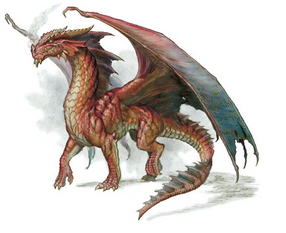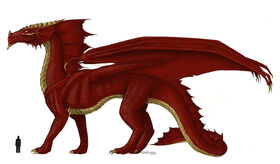Dragons are a rare kind of animal from Mythos, notable for their size and abilities.

A Western dragon, showing red colouration
Physiology[]
Physically enormous, Western Dragons can reach 35m (115ft) long and have a wingspan of 42m (138ft). Of this, their tail makes up around one third and their neck a sixth. They can mass 16 tonnes, though some have been recorded at twice this.
The dragon is a reptilian, exhibiting traits such as scaly skin and the laying of eggs. The hide of a dragon can be two inches thick, and is unlike any other material in nature, possessing exceptional fireproof properties and sufficient hardness to blunt blades striking it, even getting tougher as the dragon ages. It is much prized by lesser species and called Dragonscale. Their claws are similar, but taper to razor sharp points which can penetrate cracks within armour.
The wings of the dragon are anchored to its shoulder, just behind the clavicle. They are connected to huge pectoral muscles and have thick membranes stretched between their digit-derived supports, and are powerful enough to knock soldiers down with the downdraft. The dragon's wings do not supply sufficient power to fly, however- this is done by the flightstone.
The Flightstone is an object located by the dragon's heart, which provides a downthrust when compressed. The dragon uses it to get itself from the ground, and then to supplement its wings during flight. Flightstones are sought avidly by engineers and sorcerors, due to their potential for producing levitation.

The Average human compared to a rather large dragon
A dragon's eye sees not only light, but magical emissions. This is a property of the tears which go over its surface, rather than the eye itself, so dragon tears are also in high demand by paranoid rulers and magicians.
Life Cycle[]
The life expectancy of any given dragon is hard to predict. Generally, Westerns will live for 500 years, Sea dragons for 900, and Orientals for 2000 years.
After mating, a female lays a clutch of eggs. This is usually one for an Oriental, but can be between one and five for the other species. Most dragon eggs must be incubated constantly, but Oriental dragon eggs have a jewel-like shell which means they can be left in rivers or underground.
After between five and forty months of gestation (typically lower for Westerns and higher for the others), the baby breaks out from its egg. It is usually around 1m long at this stage, and is very vulnerable. Apart from Oriental hatchlings, these greatly resemble their parents (Oriental dragon hatchlings look like water snakes).
After around 80 years of growth, the dragon reaches its full size and becomes capable of reproducing.
Subspecies[]
There are many types of dragon, of which the best known is the Western Mountain dragon. This usually has plain colouring and a spade-tipped tail, as well as long horns and a larger body. This dragon can breathe fire, launching a stream of flame up to 20m long and 1000 degrees centigrade. Western dragons are also aggressive and have thin belly scales.
Also of note are Oriental dragons, Drakes, and sea dragons

A green-coloured Oriental Dragon
.
Orientals are more sinuous and have whiskered faces, also spending less time on the ground. They are the most friendly type of dragon, often forming bonds with exceptional individuals. They grow to 20m (66ft) long, but their wings have become vestigial and useless. They are the most magical and also the longest-lived.
Sea dragons are larger than almost all of the others, and are too large to fly. They spend time under the surface, consuming ships and then digesting for many years. They can be 70m (230ft) long, but despite this are unintelligent, barely capable of speech.
Other subspecies include Rage Dragons, Shadow Dragons, and Kebijak. Great Dragons were the first race of dragon.
Drakes are not true dragons, but a close relation. They are non-sapient, small, and have venomous blood. They can spit this from their mouths, and if they are wounded it sprays out. The chemical can dissolve through skin. They grow to 3m (10ft) long, and live for around 40 years.
Also related are the Lindworms.
Intelligence[]
Western and Oriental dragons are sapient. They have language and rapidly learn to deal with new problems.
Dragon hatchlings typically become capable of speech at fifty years old, though some have been known to develop this ability earlier.
They do not fashion tools, their natural weapons and armour being satisfactory to them. However, dragon cities can be enormous, dug deep into the mountains and having great halls and caverns.
Communication[]
The method of communication that sapient dragons use varies between subspecies and/or factions. Some dragons speak the Common Tongue while others speak languages exclusive to their race, or have other methods of communication than the aural.
Dragon Combat[]
The order of Dragonslayers advocates several ways of combating dragons.
The first is to use siege weapons, attacking from a distance with ballistae (catapults are too inaccurate). Their bolts can penetrate dragonhide.
The second is to use powerful magic. Dragons are magical beings, with high resistance and no small amount of power themselves, but an archmage should be able to counter its abilities and defeat it.
Thirdly and finally, they can be attacked in melee. Weapons such as Halberds, Greatswords, or other such tools should be used, allowing the greatest possibility of penetration, and targeted at the animal's belly (if Western) or eyes. To make sure of your kill, always stab it in the brain. If you take this approach, bring a flameproof cloak, some kind of magical protection, and much luck.